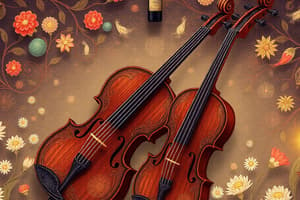Podcast
Questions and Answers
What characterizes Medieval music?
What characterizes Medieval music?
- Monodic line with vocals only (correct)
- Polyphonic structure
- Use of instruments
- Major/minor scales
What does a Modal Scale start on?
What does a Modal Scale start on?
A note other than C
Define Organom.
Define Organom.
Addition of more than one voice within the same tone
What is the meaning of 'Renaissance' in music?
What is the meaning of 'Renaissance' in music?
Describe Counter Point in music.
Describe Counter Point in music.
What does Late Renaissance music typically feature?
What does Late Renaissance music typically feature?
What era did Baroque music cover?
What era did Baroque music cover?
What are the three parts of a Sonata?
What are the three parts of a Sonata?
What is a Fugue?
What is a Fugue?
What elements define Classical music?
What elements define Classical music?
What is a defining characteristic of Romantic music?
What is a defining characteristic of Romantic music?
What describes the characteristics of 20th Century music?
What describes the characteristics of 20th Century music?
What is the Overtone Series?
What is the Overtone Series?
Flashcards are hidden until you start studying
Study Notes
Medieval
- Characterized by monodic line and vocals, devoid of instrumental accompaniment.
- Emphasizes church music and utilizes modal scales.
- Introduces the concept of organum, adding more than one voice to a single melodic line.
Modal Scale
- Distinguished by starting on notes other than C, setting the foundation for diverse musical compositions.
Organum
- A technique that involves layering multiple vocal lines, enriching the texture of the music.
Renaissance
- Signifies a "rebirth" in music, highlighting polyphonic textures and the use of counterpoint.
- Marks the emergence of leading tones and harmony (major/minor scales).
- Transition from predominantly ecclesiastical music to secular compositions with an emphasis on notated music.
Counterpoint
- Refers to the interplay between two or more independent musical lines, crucial for developing complex textures.
Late Renaissance
- Notable for melismatic singing, where a single syllable is extended over several notes, creating a sense of lightness in music.
Baroque
- spans 1600 to 1760, characterized by structured harmony and a focus on leading tones within tonal contexts.
- Recognition of orchestral instrumentation, reducing reliance on vocal components.
- Introduction of musical forms like concertos, sonatas, and fugues.
- Key composer: Johann Sebastian Bach, known for his intricate and complex works.
Sonata
- Form consists of three sections: exposition (theme introduction), development (thematic exploration), and recapitulation (returns to the main theme).
- Key to its structure is the establishment of tonality and playful thematic variations.
Fugue
- A structured form featuring a complex interweaving of melodic lines, exemplifying counterpoint throughout the composition.
Classical
- Defined by a sense of playfulness, expressive dynamics, and structured formats such as sonatas.
- Features larger orchestras and elements of surprise within compositions.
- Prominent composers include Mozart and Beethoven, who contributed significantly to the era's development.
Romantic
- Focuses on expressing deep emotion rather than strict structures.
- Instrumentation predominantly involves strings and piano, with significant use of dramatic pauses.
- Noteworthy composer: Johannes Brahms, known for his emotive and lyrical compositions.
20th Century
- Witnesses a resurgence of modal scales alongside experimental instrumentation and innovative techniques such as atonality and dissonance.
- Characteristics include minimalism, complex rhythms, and unconventional compositions expressing an intellectual approach to music.
- Key composers include Arnold Schoenberg, John Cage, and Philip Glass, who contributed to the diverse musical landscape of the century.
Overtone Series
- Explains the phenomenon of harmonic overtones created when a tone vibrates at specific frequencies, resulting in additional pitches as vibrations interact.
Studying That Suits You
Use AI to generate personalized quizzes and flashcards to suit your learning preferences.




